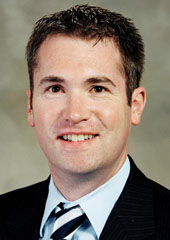Number of children living in poverty rising faster in Iowa than nation, says ISU researcher
06-02-11
Contacts:
David Peters, Sociology, 515-294-1122, dpeters@iastate.edu
Dan Kuester, News Service, 515-294-0704,
kuester@iastate.edu
Number of children living in poverty rising faster in Iowa than nation, says ISU researcher
AMES, Iowa - The number of Iowa children in households with incomes below the poverty line is growing faster than the national average, according to an Iowa State University study.
David Peters, assistant professor in the Department of Sociology, analyzed data from the U.S. Census Bureau's American Community Survey and compared Iowa's rates of poverty to the national figures.
At first glance, Iowa's numbers compare favorably, with 13.5 percent of the state's children living in poverty compared with 18.2 percent nationally.
Peters warns, however, that the last decade has seen some disturbing changes.
"One of the big trends is that child poverty is growing faster in Iowa than it is nationally," Peters said. "So even though we have lower rates than nationally, we are catching up to the national average."
In the past 10 years, poverty rates for Iowa's children have gone up 3.1 percent, while the national increase has been just 2.1 percent.
For the years 1969 through 2009, the rate of Iowa children living in poverty has grown by 3.5 percent while the national increase was 3.1 percent.
In other words, national rates have slowed down and Iowa's rates have sped up.
Iowa's areas defined as micropolitan -- cities that are bigger than rural areas but not major cities -- have been the hardest hit by child poverty, particularly northern cities that had manufacturing or industrial economies in the past, such as Fort Dodge, Waterloo, Marshalltown and Sioux City, according to Peters.
For example, from 1969 to 2009, while the United State's rates of children in poverty have grown at that 3.1 percent rate, the rates for micropolitan Iowa cities have climbed 6.1 percent, almost twice the national rate of growth.
Peters says this increase is due to several factors.
"The economies of these micropolitan areas are built on manufacturing that require low-skilled labor," he said. "Many of the poor children in these areas are people who move here from other states or countries to get these jobs. Meantime, Iowa's kids, who are relatively well educated, often leave the state to get higher-paying, higher-skilled jobs."
Peters also says part of the problem is that in the past four decades, there has been a shift in the culture of poverty.
"There is less social mobility for poor children, and this has created persistent poverty across generations and places -- something that was not the case 50 years ago," said Peters. "Today, growing up in a poor family is the single biggest predictor of a child being poor as an adult."
Peters says the situation can be improved if children living in poverty have an opportunity to "break the cycle."
Micropolitan areas have another hurdle to overcome, according to Peters.
The rates of poverty are increasing, but the overall numbers of children in poverty are not very large, so they don't get the attention of lawmakers.
"The percentage of children in poverty in these areas is very high," he said. "But the numbers are small, so micropolitan areas are not getting the help they need."
Peters' complete report is online here.
-30-
